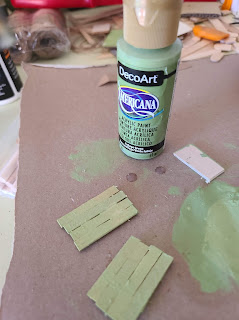Working on my first dollhouse furniture using craft sticks. I am excited to give this a go and with my Proxxon tools it will make easy work of it.
I am building a large dining room table with a rustic farmhouse feel. It is painted, distressed and has twine wrapped legs with custom wood placemats to match.
Lets get started...
First cut the ends of the craft sticks with your table saw, lay out your sticks. Take two or three other sticks and glue to the back with Beacon Adhesives Timber Grip adhesive. This will stabilize your table top.
Once dried, cut down the sides evenly with the table saw. Then put the edge of the table top at the edge of your workbench. Using the edge as a guide, sand the edges even.
Now for the legs using small dowels, cut four the same size and sand the rough edges.
Add Beacons Timber Grip adhesive to the leg and wrap with twine.
Turn the table top over and add the legs with the same adhesive.
Start painting both bottom and top. Let dry. Once dry, sand to give it a distressed look.
Now to make the placemats. Same principal as the table top on a much smaller scale. Paint and sand to make uniform and distressed.
Final touch is the table cloth made from a scrap piece of patterned kraft paper. Cut to size and using Beacons Hobby Coat adhere it to the top of the table and let dry.
Now to put your table setting together.
Thank you for stopping by!
Candy Rosenberg aka "A Vintage Girl"
www.AVintageGirl.com



























































